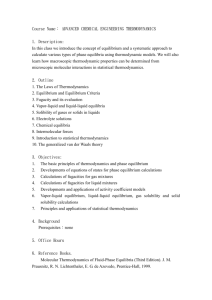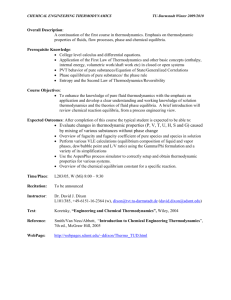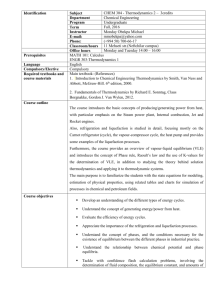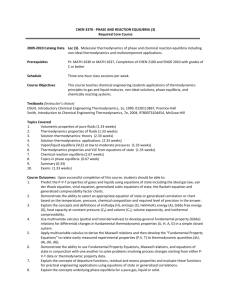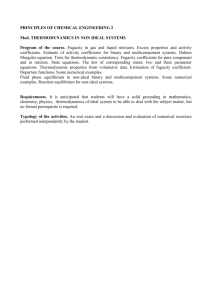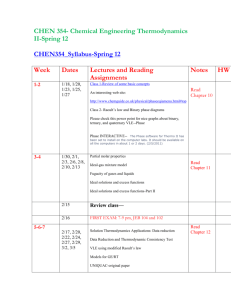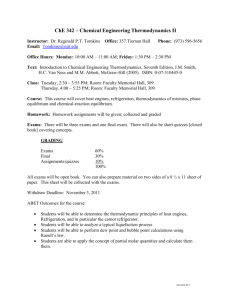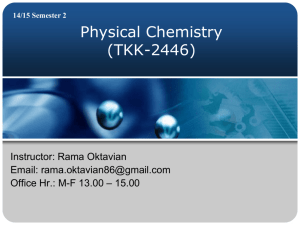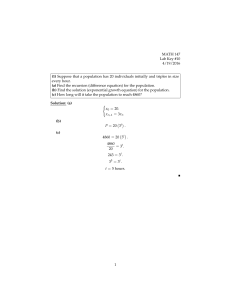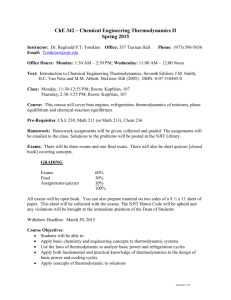CH-223 Quantitative Analysis
advertisement
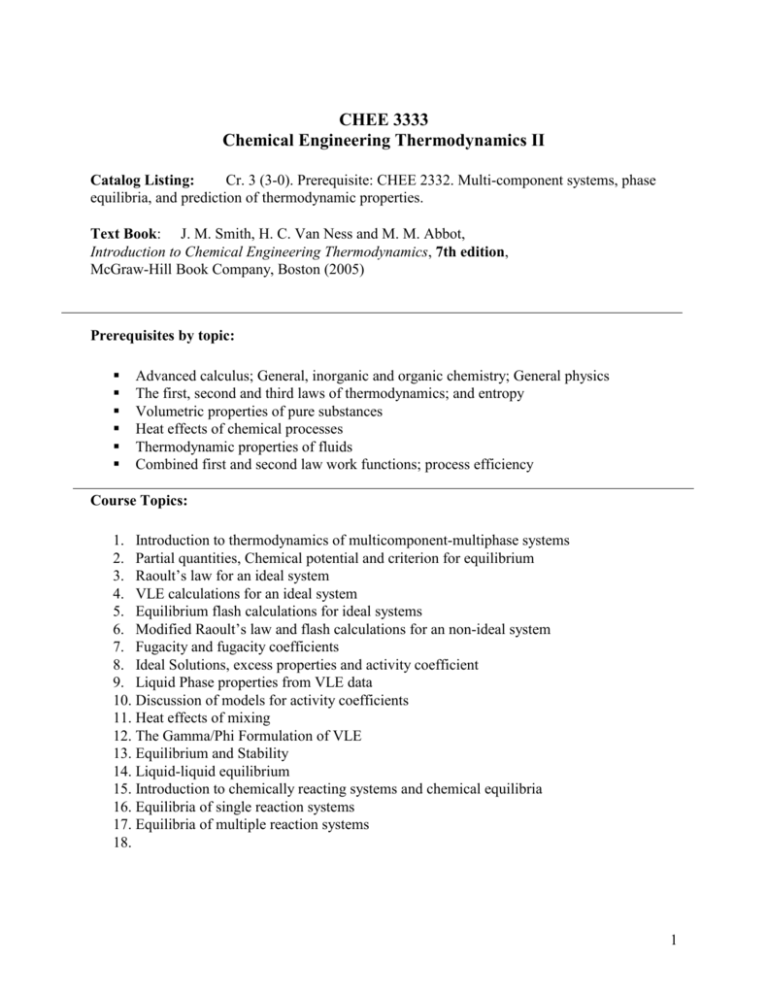
CHEE 3333 Chemical Engineering Thermodynamics II Catalog Listing: Cr. 3 (3-0). Prerequisite: CHEE 2332. Multi-component systems, phase equilibria, and prediction of thermodynamic properties. Text Book: J. M. Smith, H. C. Van Ness and M. M. Abbot, Introduction to Chemical Engineering Thermodynamics, 7th edition, McGraw-Hill Book Company, Boston (2005) Prerequisites by topic: Advanced calculus; General, inorganic and organic chemistry; General physics The first, second and third laws of thermodynamics; and entropy Volumetric properties of pure substances Heat effects of chemical processes Thermodynamic properties of fluids Combined first and second law work functions; process efficiency Course Topics: 1. Introduction to thermodynamics of multicomponent-multiphase systems 2. Partial quantities, Chemical potential and criterion for equilibrium 3. Raoult’s law for an ideal system 4. VLE calculations for an ideal system 5. Equilibrium flash calculations for ideal systems 6. Modified Raoult’s law and flash calculations for an non-ideal system 7. Fugacity and fugacity coefficients 8. Ideal Solutions, excess properties and activity coefficient 9. Liquid Phase properties from VLE data 10. Discussion of models for activity coefficients 11. Heat effects of mixing 12. The Gamma/Phi Formulation of VLE 13. Equilibrium and Stability 14. Liquid-liquid equilibrium 15. Introduction to chemically reacting systems and chemical equilibria 16. Equilibria of single reaction systems 17. Equilibria of multiple reaction systems 18. 1 Expected Course Outcomes and Performance Criteria: Demonstrate knowledge of the thermodynamics of partial molar quantities, fugacities, activity coefficients, ideal and non-ideal solutions, chemical equilibria conditions of multi-component, multi-phase, and reactive systems, vapor-liquid, liquid-liquid, solidliquid, solid-vapor, Raoult’s law, Henry’s law, activity coefficient models. (a)1 Demonstrate ability to apply the knowledge of equilibria of multi-component, multi-phse systems to the evaluation and design of distilliation, fractionation, and other separation processes. (a, e) Demonstrate ability to work in a team on a design project, communicate with peers and submit a written report on that project. (g) 1 Lowercase letters in parentheses refer to ABET outcomes under Criterion 3 (see Appendix). 2 Appendix ABET Outcome, Criterion 3 (a) an ability to apply knowledge of mathematics, science and engineering. (b) an ability to design and conduct experiments as well as to analyze and interpret data. (c) an ability to design a system, component, or process to meet desired needs within realistic constraints such as economic, environmental, social, political, ethical, health & safety, manufacturability, and sustainability. (d) an ability to function on multidisciplinary teams. (e) an ability to identify, formulate and solve engineering problems. Program-Specific Outcomes Use chemistry and physics concepts to set up and solve chemical engineering problems Use mathematical tools to solve chemical engineering problems Select appropriate experimental equipment and techniques necessary to solve a given problem Evaluate and interpret experimental results using statistical tools and chemical engineering concepts Apply material and energy balance concepts to design a unit operation Define objectives and perform the design of an integrated chemical process under realistic constraints (f) an understanding of professional and ethical responsibility. (g) an ability to communicate effectively. (h) the broad education necessary to understand the impact of engineering solutions in a global, economic, environmental, and societal context. (i) a recognition of the need for and an ability to engage in life-long learning. (j) a knowledge of contemporary issues. (k) an ability to use the techniques, skills, and modern engineering tools necessary for engineering practice. Define roles and responsibilities to align with capabilities of team members and fulfill project requirements Develop and carry out a project plan through team work Translate an engineering problem into a mathematical model or other suitable abstraction Use mathematical model or other suitable abstraction to solve an engineering problem and interpret results Demonstrate knowledge of professional code of ethics. Identify ethical issues and make decisions for a chemical engineering problem. Make presentations that are factual and tailored to the audience Can communicate in writing to non-technical and technical audiences Understand the impact of chemical engineering solutions in a global, economic, environmental, and societal context. Recognize the importance of advanced education and development opportunities Identify, retrieve, and organize information necessary to solve open-ended problems Know the interplay between current technical and societal issues Know the recent history, current status, and future trends of chemical engineering Use modern software to solve chemical engineering problems Understand how to operate equipment relevant to chemical engineering systems 3
